DSPL 架构
使用集合让一切井井有条
根据您的偏好保存内容并对其进行分类。
此页面及其关联的子页面介绍了 DSPL XML 架构。
本资料适用于想要了解
语言的低层细节;对大多数用户而言
在 <ph type="x-smartling-placeholder"></ph>
开发者指南应足以创建和修改
DSPL 数据集。
您可以以 XSD 格式下载完整的 XML 架构
在 <ph type="x-smartling-placeholder"></ph>
DSPL 代码网站。
元素:dspl
| 命名空间 |
http://schemas.google.com/dspl/2010 |
| 注释 |
DSPL 规范描述了数据集。数据集是
由其命名空间标识数据集包含以下要素
表格:
数据集 - 概念:
数据集 - 切片:
数据集 - 主题:用于组织概念的分层标签
数据集 |
| 图示 |
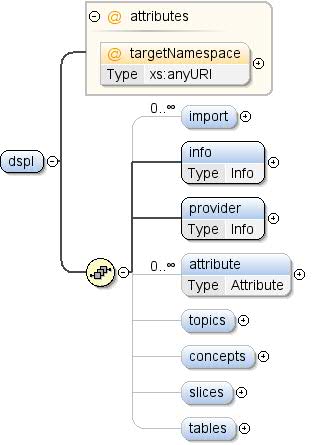 |
| 属性 |
|
| 型号 |
import*、info、provider、
attribute*、topics{0,1}、concepts{0,1}、slices{0,1}、tables{0,1} |
| 儿童 |
attribute、concepts、import
info、provider、slices、
表格、主题 |
| 实例 |
<dspl targetNamespace="">
<import location="" namespace="">{0,unbounded}</import>
<info>{1,1}</info>
<provider>{1,1}</provider>
<attribute concept="" id="">{0,unbounded}</attribute>
<topics>{0,1}</topics>
<concepts>{0,1}</concepts>
<slices>{0,1}</slices>
<tables>{0,1}</tables>
</dspl>
|
| 属性 |
| QName |
类型 |
固定 |
默认 |
使用 |
注解 |
| targetNamespace |
xs:anyURI |
|
|
可选 |
每个数据集都可以提供一个目标命名空间。目标
命名空间是对数据集进行唯一标识的 URI。有关
有关在 XML 中使用命名空间的信息,请参阅:
http://www.w3.org/TR/REC-xml-names/ 如果没有 targetNamespace
那么当数据集被覆盖时,
。 |
|
| 来源 |
<xs:element name="dspl">
<xs:annotation>
<xs:documentation>A DSPL specification describes a dataset. A dataset is
identified by its namespace. A dataset is comprised of the
following elements:
- Tables: Data for the concepts and slices defined in the
dataset
- Concepts: User-specified definitions and structures used in
the dataset
- Slices: Combinations of dimensions and metrics present in
the dataset
- Topics: Hierarchical labels used to organise the concepts of
the dataset</xs:documentation>
</xs:annotation>
<xs:complexType>
<xs:sequence>
<xs:element name="import" minOccurs="0" maxOccurs="unbounded">
<xs:annotation>
<xs:documentation>Import directive for external datasets -- modeled after
the XML Schema import directive. In order to use
elements defined in an external dataset, the external
dataset must be referenced using an import directive.</xs:documentation>
</xs:annotation>
<xs:complexType>
<xs:attribute name="namespace" use="required">
<xs:annotation>
<xs:documentation>The namespace of the imported dataset, specified as
a URI. A prefix must be associated with this
namespace before its contents can be referenced. See
[XML Namespaces] for more information about the use
of namespaces and prefixes in XML.</xs:documentation>
</xs:annotation>
</xs:attribute>
<xs:attribute name="location" use="optional">
<xs:annotation>
<xs:documentation>An optional location where the definition of the
imported dataset can be found, specified as a
URL. If the location is omitted, the system
processing this DSPL dataset must already know the
imported dataset.
Implementation note: The Google dataset importer
ignores the location attribute. Any imported dataset
must be known by the Google importer beforehand.</xs:documentation>
</xs:annotation>
</xs:attribute>
</xs:complexType>
</xs:element>
<xs:element name="info" type="Info" minOccurs="1">
<xs:annotation>
<xs:documentation>General information about the dataset.</xs:documentation>
</xs:annotation>
</xs:element>
<xs:element name="provider" type="Info">
<xs:annotation>
<xs:documentation>General information about the dataset provider.</xs:documentation>
</xs:annotation>
</xs:element>
<xs:element name="attribute" type="Attribute" minOccurs="0" maxOccurs="unbounded">
<xs:annotation>
<xs:documentation>Attribute associated with the dataset.</xs:documentation>
</xs:annotation>
</xs:element>
<xs:element name="topics" minOccurs="0">
<xs:annotation>
<xs:documentation>A hierarchy of topics used to organize the contents of
the dataset. The order in which topics are given is
meaningful and should be respected by visualizations
that displays these topics.</xs:documentation>
</xs:annotation>
<xs:complexType>
<xs:sequence>
<xs:element name="topic" type="Topic" maxOccurs="unbounded"/>
</xs:sequence>
</xs:complexType>
</xs:element>
<xs:element name="concepts" minOccurs="0">
<xs:annotation>
<xs:documentation>A list of concepts defined in this dataset.</xs:documentation>
</xs:annotation>
<xs:complexType>
<xs:sequence>
<xs:element name="concept" type="Concept" maxOccurs="unbounded"/>
</xs:sequence>
</xs:complexType>
</xs:element>
<xs:element name="slices" minOccurs="0">
<xs:annotation>
<xs:documentation>A list of slices defined in this dataset.</xs:documentation>
</xs:annotation>
<xs:complexType>
<xs:sequence>
<xs:element name="slice" type="Slice" maxOccurs="unbounded"/>
</xs:sequence>
</xs:complexType>
</xs:element>
<xs:element name="tables" minOccurs="0">
<xs:annotation>
<xs:documentation>A list of tables defined in this dataset.</xs:documentation>
</xs:annotation>
<xs:complexType>
<xs:sequence>
<xs:element name="table" type="Table" maxOccurs="unbounded"/>
</xs:sequence>
</xs:complexType>
</xs:element>
</xs:sequence>
<xs:attribute name="targetNamespace" type="xs:anyURI" use="optional">
<xs:annotation>
<xs:documentation>Each dataset may provide a target namespace. The
target namespace is a URI that uniquely identifies the
dataset. For more information about the use of namespaces in XML,
see:
http://www.w3.org/TR/REC-xml-names/
If no targetNamespace is provided, then a namespace will be
generated when the dataset is imported.</xs:documentation>
</xs:annotation>
</xs:attribute>
</xs:complexType>
</xs:element>
|
元素:dspl / import
| 命名空间 |
http://schemas.google.com/dspl/2010 |
| 注释 |
外部数据集的导入指令 - 根据 XML 建模
架构导入指令。为了使用在外部
数据集,必须使用导入方法引用外部数据集
指令。 |
| 图示 |
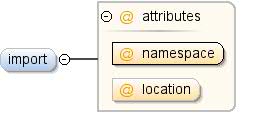 |
| 属性 |
| content: |
复杂 |
| 最少发生次数: |
0 |
| maxOccurs: |
无界限 |
|
| 属性 |
| QName |
类型 |
固定 |
默认 |
使用 |
注解 |
| 位置 |
|
|
|
可选 |
导入文件的定义所在的可选位置
数据集(以网址的形式指定)。如果该地理位置为
则处理此 DSPL 数据集的系统必须已知晓
导入的数据集。实现说明:Google 数据集
importer 会忽略 location 属性。任何导入的数据集都必须
Google 导入方会预先知悉。 |
| namespace |
|
|
|
必填 |
导入数据集的命名空间,以
URI前缀必须与此命名空间相关联,然后再为其
可以引用内容如需了解详情,请参阅 [XML 命名空间]
命名空间和前缀的
XML。 |
|
| 来源 |
<xs:element name="import" minOccurs="0" maxOccurs="unbounded">
<xs:annotation>
<xs:documentation>Import directive for external datasets -- modeled after
the XML Schema import directive. In order to use
elements defined in an external dataset, the external
dataset must be referenced using an import directive.</xs:documentation>
</xs:annotation>
<xs:complexType>
<xs:attribute name="namespace" use="required">
<xs:annotation>
<xs:documentation>The namespace of the imported dataset, specified as
a URI. A prefix must be associated with this
namespace before its contents can be referenced. See
[XML Namespaces] for more information about the use
of namespaces and prefixes in XML.</xs:documentation>
</xs:annotation>
</xs:attribute>
<xs:attribute name="location" use="optional">
<xs:annotation>
<xs:documentation>An optional location where the definition of the
imported dataset can be found, specified as a
URL. If the location is omitted, the system
processing this DSPL dataset must already know the
imported dataset.
Implementation note: The Google dataset importer
ignores the location attribute. Any imported dataset
must be known by the Google importer beforehand.</xs:documentation>
</xs:annotation>
</xs:attribute>
</xs:complexType>
</xs:element>
|
元素:dspl / info
| 命名空间 |
http://schemas.google.com/dspl/2010 |
| 注释 |
有关数据集的一般信息。 |
| 图示 |
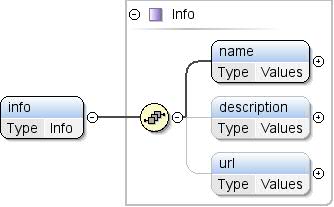 |
| 类型 |
信息 |
| 属性 |
|
| 型号 |
name、description{0,1}、url{0,1} |
| 儿童 |
description、name、url |
| 实例 |
<info>
<name>{1,1}</name>
<description>{0,1}</description>
<url>{0,1}</url>
</info>
|
| 来源 |
<xs:element name="info" type="Info" minOccurs="1">
<xs:annotation>
<xs:documentation>General information about the dataset.</xs:documentation>
</xs:annotation>
</xs:element>
|
元素:dspl / provider
| 命名空间 |
http://schemas.google.com/dspl/2010 |
| 注释 |
有关数据集提供商的常规信息。 |
| 图示 |
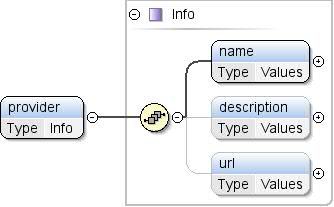 |
| 类型 |
信息 |
| 属性 |
|
| 型号 |
name、description{0,1}、url{0,1} |
| 儿童 |
description、name、url |
| 实例 |
<provider>
<name>{1,1}</name>
<description>{0,1}</description>
<url>{0,1}</url>
</provider>
|
| 来源 |
<xs:element name="provider" type="Info">
<xs:annotation>
<xs:documentation>General information about the dataset provider.</xs:documentation>
</xs:annotation>
</xs:element>
|
| 命名空间 |
http://schemas.google.com/dspl/2010 |
| 注释 |
与数据集关联的属性。 |
| 图示 |
 |
| 类型 |
属性 |
| 属性 |
| content: |
复杂 |
| 最少发生次数: |
0 |
| maxOccurs: |
无界限 |
|
| 型号 |
info{0,1}、type{0,1}、(value*
|conceptValue{0,1}) |
| 儿童 |
conceptValue、info、type、
值 |
| 实例 |
<attribute concept="" id="">
<info>{0,1}</info>
<type format="" ref="">{0,1}</type>
</attribute>
|
| 属性 |
| QName |
类型 |
固定 |
默认 |
使用 |
注解 |
| 概念 |
xs:QName |
|
|
可选 |
对与值对应的概念的引用
属性。如果属性指定类型,则该类型
必须与所引用概念的类型相匹配。对
外部概念必须采用以下格式
“prefix:other_concept_id”,其中“前缀”为
用于外部数据集的命名空间的前缀(请参阅 XML)
命名空间)。 |
| id |
LocalId |
|
|
可选 |
概念属性的 ID。此标识符必须是
在概念内是唯一的(在所有属性和属性之间)。通过
如果指定了 concept 属性,则可以省略 id。在该部分中,
会隐式创建 ID,其值为
引用的概念例如 <attribute
concept="unit:currency"/>等同于
<attribute id="currency"
concept="unit:currency"/> |
|
| 来源 |
<xs:element name="attribute" type="Attribute" minOccurs="0" maxOccurs="unbounded">
<xs:annotation>
<xs:documentation>Attribute associated with the dataset.</xs:documentation>
</xs:annotation>
</xs:element>
|
| 命名空间 |
http://schemas.google.com/dspl/2010 |
| 注释 |
一个主题的层次结构,用于组织以下主题的内容:
数据集。主题的指定顺序有意义,
并遵循显示这些主题的可视化图表。 |
| 图示 |
 |
| 属性 |
|
| 型号 |
主题+ |
| 儿童 |
主题 |
| 实例 |
<topics>
<topic id="" parentTopic="">{1,unbounded}</topic>
</topics>
|
| 来源 |
<xs:element name="topics" minOccurs="0">
<xs:annotation>
<xs:documentation>A hierarchy of topics used to organize the contents of
the dataset. The order in which topics are given is
meaningful and should be respected by visualizations
that displays these topics.</xs:documentation>
</xs:annotation>
<xs:complexType>
<xs:sequence>
<xs:element name="topic" type="Topic" maxOccurs="unbounded"/>
</xs:sequence>
</xs:complexType>
</xs:element>
|
| 命名空间 |
http://schemas.google.com/dspl/2010 |
| 图示 |
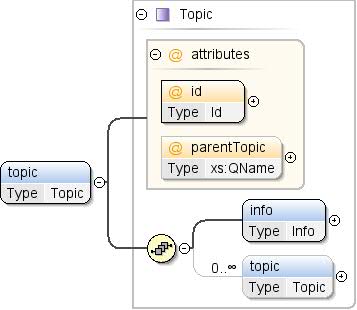 |
| 类型 |
主题 |
| 属性 |
| content: |
复杂 |
| maxOccurs: |
无界限 |
|
| 型号 |
信息、topic* |
| 儿童 |
info、topic |
| 实例 |
<topic id="" parentTopic="">
<info>{1,1}</info>
<topic id="" parentTopic="">{0,unbounded}</topic>
</topic>
|
| 属性 |
| QName |
类型 |
固定 |
默认 |
使用 |
注解 |
| id |
ID |
|
|
必填 |
数据集。 |
| parentTopic |
xs:QName |
|
|
可选 |
此主题的父级主题的 ID(如果有)。
无法为内嵌的主题指定 parentTopic
其他主题。 |
|
| 来源 |
<xs:element name="topic" type="Topic" maxOccurs="unbounded"/>
|
| 命名空间 |
http://schemas.google.com/dspl/2010 |
| 注释 |
此数据集中定义的概念列表。 |
| 图示 |
 |
| 属性 |
|
| 型号 |
概念+ |
| 儿童 |
概念 |
| 实例 |
<concepts>
<concept extends="" id="">{1,unbounded}</concept>
</concepts>
|
| 来源 |
<xs:element name="concepts" minOccurs="0">
<xs:annotation>
<xs:documentation>A list of concepts defined in this dataset.</xs:documentation>
</xs:annotation>
<xs:complexType>
<xs:sequence>
<xs:element name="concept" type="Concept" maxOccurs="unbounded"/>
</xs:sequence>
</xs:complexType>
</xs:element>
|
| 命名空间 |
http://schemas.google.com/dspl/2010 |
| 图示 |
 |
| 类型 |
概念 |
| 属性 |
| content: |
复杂 |
| maxOccurs: |
无界限 |
|
| 型号 |
info、topic*、type{0,1}、
attribute*、property*、defaultValue{0,1}、table{0,1} |
| 儿童 |
attribute、defaultValue、info、
property、table、topic、
类型 |
| 实例 |
<concept extends="" id="">
<info>{1,1}</info>
<topic ref="">{0,unbounded}</topic>
<type ref="">{0,1}</type>
<attribute concept="" id="">{0,unbounded}</attribute>
<property concept="" id="" isMapping="false" isParent="false">{0,unbounded}</property>
<defaultValue>{0,1}</defaultValue>
<table ref="">{0,1}</table>
</concept>
|
| 属性 |
| QName |
类型 |
固定 |
默认 |
使用 |
注解 |
| 扩展 |
xs:QName |
|
|
可选 |
此概念所代表的概念的唯一标识符
扩展。引用的概念可以在同一数据集中定义
或外部(即存储在另一个数据集中)。对外部 API 的引用
概念必须采用如下格式:“prefix:other_concept_id”
其中“prefix”是
外部数据集(请参阅 XML 命名空间)。 |
| id |
ID |
|
|
必填 |
概念的唯一标识符,必须为
在数据集内具有全局唯一性。 |
|
| 来源 |
<xs:element name="concept" type="Concept" maxOccurs="unbounded"/>
|
元素:dspl / slice
| 命名空间 |
http://schemas.google.com/dspl/2010 |
| 注释 |
此数据集中定义的切片列表。 |
| 图示 |
 |
| 属性 |
|
| 型号 |
切片+ |
| 儿童 |
slice |
| 实例 |
<slices>
<slice id="">{1,unbounded}</slice>
</slices>
|
| 来源 |
<xs:element name="slices" minOccurs="0">
<xs:annotation>
<xs:documentation>A list of slices defined in this dataset.</xs:documentation>
</xs:annotation>
<xs:complexType>
<xs:sequence>
<xs:element name="slice" type="Slice" maxOccurs="unbounded"/>
</xs:sequence>
</xs:complexType>
</xs:element>
|
| 命名空间 |
http://schemas.google.com/dspl/2010 |
| 图示 |
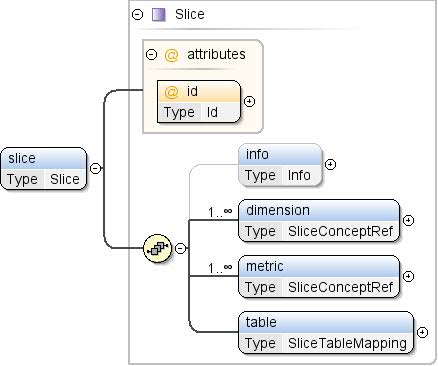 |
| 类型 |
Slice |
| 属性 |
| content: |
复杂 |
| maxOccurs: |
无界限 |
|
| 型号 |
info{0,1}、dimension+、metric+
、表格 |
| 儿童 |
dimension、info、metric、
表格 |
| 实例 |
<slice id="">
<info>{0,1}</info>
<dimension concept="">{1,unbounded}</dimension>
<metric concept="">{1,unbounded}</metric>
<table ref="">{1,1}</table>
</slice>
|
| 属性 |
| QName |
类型 |
固定 |
默认 |
使用 |
注解 |
| id |
ID |
|
|
必填 |
切片的唯一标识符。 |
|
| 来源 |
<xs:element name="slice" type="Slice" maxOccurs="unbounded"/>
|
| 命名空间 |
http://schemas.google.com/dspl/2010 |
| 注释 |
此数据集中定义的表的列表。 |
| 图示 |
 |
| 属性 |
|
| 型号 |
表格+ |
| 儿童 |
表格 |
| 实例 |
<tables>
<table id="">{1,unbounded}</table>
</tables>
|
| 来源 |
<xs:element name="tables" minOccurs="0">
<xs:annotation>
<xs:documentation>A list of tables defined in this dataset.</xs:documentation>
</xs:annotation>
<xs:complexType>
<xs:sequence>
<xs:element name="table" type="Table" maxOccurs="unbounded"/>
</xs:sequence>
</xs:complexType>
</xs:element>
|
| 命名空间 |
http://schemas.google.com/dspl/2010 |
| 图示 |
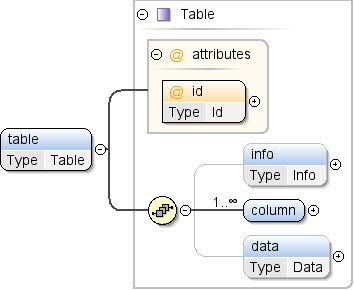 |
| 类型 |
表格 |
| 属性 |
| content: |
复杂 |
| maxOccurs: |
无界限 |
|
| 型号 |
info{0,1}、column+、data{0,1} |
| 儿童 |
列、数据、信息 |
| 实例 |
<table id="">
<info>{0,1}</info>
<column format="" id="" type="">{1,unbounded}</column>
<data>{0,1}</data>
</table>
|
| 属性 |
| QName |
类型 |
固定 |
默认 |
使用 |
注解 |
| id |
ID |
|
|
必填 |
数据集。 |
|
| 来源 |
<xs:element name="table" type="Table" maxOccurs="unbounded"/>
|
| 命名空间 |
没有命名空间 |
| 注释 |
导入数据集的命名空间,以 URI 的形式指定。答
前缀必须与此命名空间相关联,其内容才能
引用。请参阅 [XML 命名空间],详细了解如何使用
命名空间和前缀。 |
| 属性 |
|
| 使用方数量 |
|
| 来源 |
<xs:attribute name="namespace" use="required">
<xs:annotation>
<xs:documentation>The namespace of the imported dataset, specified as
a URI. A prefix must be associated with this
namespace before its contents can be referenced. See
[XML Namespaces] for more information about the use
of namespaces and prefixes in XML.</xs:documentation>
</xs:annotation>
</xs:attribute>
|
| 命名空间 |
没有命名空间 |
| 注释 |
导入文件的定义所在的可选位置
数据集(以网址的形式指定)。如果省略位置,
处理此 DSPL 数据集的系统必须已经知道导入的
数据集。实现说明:Google 数据集导入程序会忽略
location 属性。所有导入的数据集都必须为 Google 所知
导入文件。 |
| 属性 |
|
| 使用方数量 |
|
| 来源 |
<xs:attribute name="location" use="optional">
<xs:annotation>
<xs:documentation>An optional location where the definition of the
imported dataset can be found, specified as a
URL. If the location is omitted, the system
processing this DSPL dataset must already know the
imported dataset.
Implementation note: The Google dataset importer
ignores the location attribute. Any imported dataset
must be known by the Google importer beforehand.</xs:documentation>
</xs:annotation>
</xs:attribute>
|
属性:dspl / @targetNamespace
| 命名空间 |
没有命名空间 |
| 注释 |
每个数据集都可以提供一个目标命名空间。目标
命名空间是对数据集进行唯一标识的 URI。有关
有关在 XML 中使用命名空间的信息,请参阅:
http://www.w3.org/TR/REC-xml-names/ 如果未提供 targetNamespace,
创建数据集时,系统会
。 |
| 类型 |
xs:anyURI |
| 属性 |
|
| 使用方数量 |
|
| 来源 |
<xs:attribute name="targetNamespace" type="xs:anyURI" use="optional">
<xs:annotation>
<xs:documentation>Each dataset may provide a target namespace. The
target namespace is a URI that uniquely identifies the
dataset. For more information about the use of namespaces in XML,
see:
http://www.w3.org/TR/REC-xml-names/
If no targetNamespace is provided, then a namespace will be
generated when the dataset is imported.</xs:documentation>
</xs:annotation>
</xs:attribute>
|
使用
oXygen XML Editor。
如未另行说明,那么本页面中的内容已根据知识共享署名 4.0 许可获得了许可,并且代码示例已根据 Apache 2.0 许可获得了许可。有关详情,请参阅 Google 开发者网站政策。Java 是 Oracle 和/或其关联公司的注册商标。
最后更新时间 (UTC):2025-07-25。
[[["易于理解","easyToUnderstand","thumb-up"],["解决了我的问题","solvedMyProblem","thumb-up"],["其他","otherUp","thumb-up"]],[["没有我需要的信息","missingTheInformationINeed","thumb-down"],["太复杂/步骤太多","tooComplicatedTooManySteps","thumb-down"],["内容需要更新","outOfDate","thumb-down"],["翻译问题","translationIssue","thumb-down"],["示例/代码问题","samplesCodeIssue","thumb-down"],["其他","otherDown","thumb-down"]],["最后更新时间 (UTC):2025-07-25。"],[],["The DSPL XML schema defines a dataset's structure using key components: `tables`, `concepts`, `slices`, and `topics`. The root `dspl` element encapsulates the dataset, utilizing `import` to reference externals, `info` and `provider` for metadata, `attribute` for dataset attributes, and `topics` to hierarchically organize the concepts. `concepts`, `slices`, `tables` are for concept definition, slice definition, and data table, respectively. Each element like `import`, `info`, `provider`, `attribute`, `topic`, `concept`, `slice`, `table` uses specific attributes and child elements for configuration. Each element has a specific cardinality that is defined in the document.\n"]]













